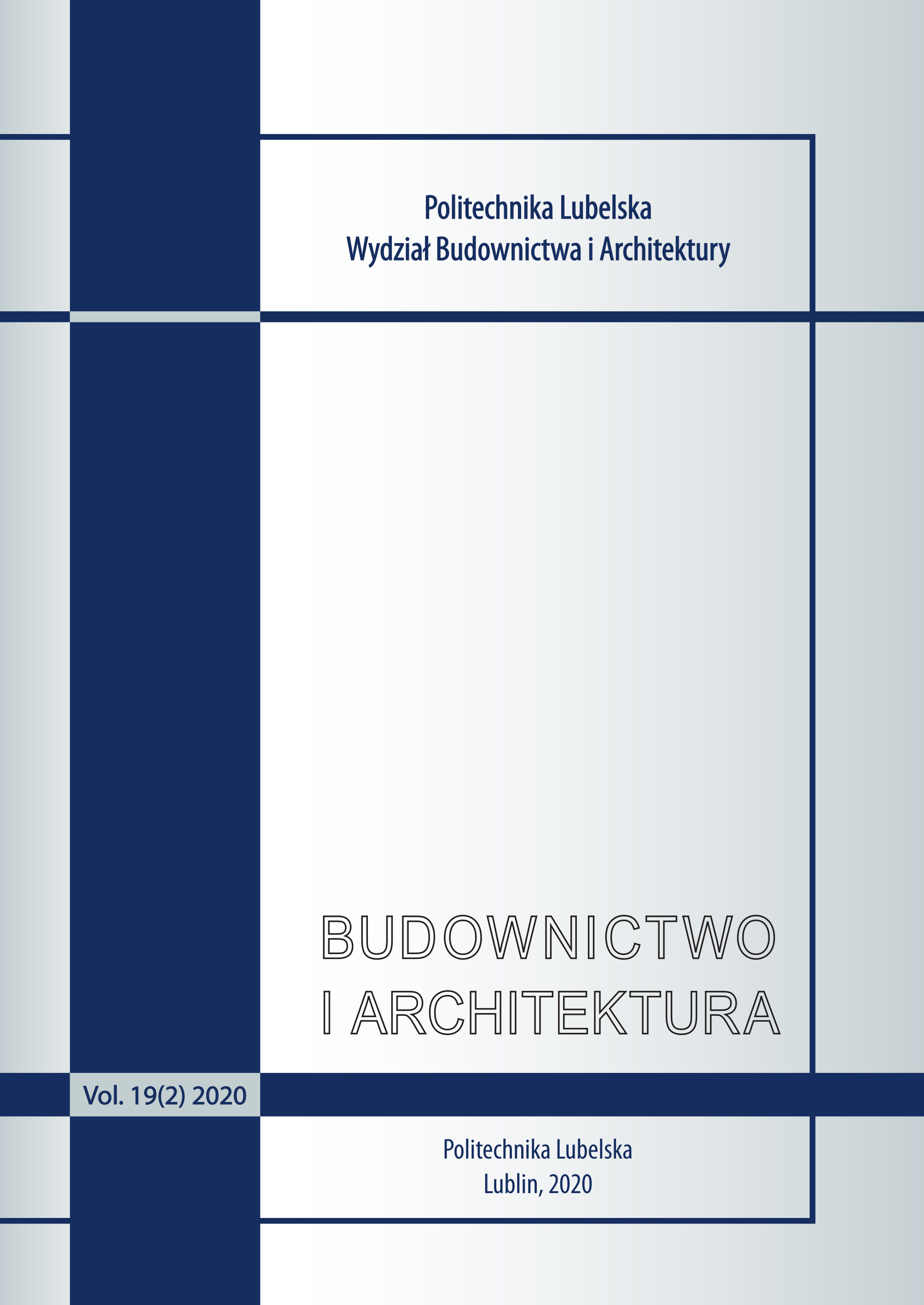Wind aspects in built environment
Article Sidebar
Issue Vol. 21 No. 3 (2022)
-
Application of sawdust concrete in construction
Oliwia Kropidłowska005-018
-
Wind aspects in built environment
Katarzyna Klemm019-034
-
Influence of outdoor advertisements on architecture in the City of Lublin
Małgorzata Kozak035-050
Archives
-
Vol. 23 No. 4
2025-01-02 11
-
Vol. 23 No. 3
2024-10-07 10
-
Vol. 23 No. 2
2024-06-15 8
-
Vol. 23 No. 1
2024-03-29 6
-
Vol. 22 No. 4
2023-12-29 9
-
Vol. 22 No. 3
2023-09-29 5
-
Vol. 22 No. 2
2023-06-30 3
-
Vol. 22 No. 1
2023-03-30 3
-
Vol. 21 No. 4
2022-12-14 8
-
Vol. 21 No. 3
2022-11-02 3
-
Vol. 21 No. 2
2022-08-31 3
-
Vol. 21 No. 1
2022-03-30 3
-
Vol. 20 No. 4
2021-12-29 6
-
Vol. 20 No. 3
2021-10-29 8
-
Vol. 20 No. 2
2021-06-02 8
-
Vol. 20 No. 1
2021-02-09 8
-
Vol. 19 No. 4
2020-11-02 11
-
Vol. 19 No. 3
2020-09-30 11
-
Vol. 19 No. 2
2020-06-30 10
-
Vol. 19 No. 1
2020-06-02 8
Main Article Content
DOI
Authors
Abstract
The dynamic development of built-up areas observed in the last few decades resulted in strong environmental transformations, especially in terms of climate phenomena. One of the factors which significantly affects the climate and bioclimate of urban areas is wind. Wind can cause discomfort to pedestrians or heat loss in buildings, if the wind speed around buildings is too high. The paper presents two examples of research conducted by the author, related to the issues of wind flow in built-up areas, based on the numerical simulations. The numerical simulations become an increasingly frequently used tool to determine the wind climate. Simulation results provide designers with important information on the influence of the buildings and their layout on the local changes in airflow. They allow testing of alternative solutions and effectiveness of various remedial measures.
Keywords:
References
Stawicka – Wałkowska M., Budownictwo przyjazne środowisku naturalnemu w aspekcie strategii zrównoważonego rozwoju. Łódź: Sekcja Fizyki Budowli Komitet Inżynierii Lądowej i Wodnej PAN, 2011.
Lewińska J., Klimat miasta. Zasoby, zagrożenia, kształtowanie., Krakow: IGPiK, 2000.
Murakami S., Uehara K., Komine H., “Amplification of wind speed at ground level due to construction of high-rise building in urban area”, Journal of Wind Engineering and Industrial Aerodynamics, no. 4, 1979, pp. 343-370. https://doi.org/10.1016/0167-6105(79)90012-6 DOI: https://doi.org/10.1016/0167-6105(79)90012-6
Cook N.J., The designers guide to wind loading of building structures Part 1: Static structures. London: Butterworths, 2000.
Paterson D.A., Papenfuss A.T., “Computation of wind flows around two tall buildings”, Journal of Wind Engineering and Industrial Aerodynamics, no. 50, 1993, pp. 69-74. https://doi.org/10.1016/0167-6105(93)90062-S DOI: https://doi.org/10.1016/0167-6105(93)90062-S
Blocken B., Roels S., Carmeliet J.B., A numerical study of wind nuisance for a high-rise building group, Proc. 2nd International Building Physics Conference, Leuven, 2003, pp. 981-990.
Isyumov N., “Studies of pedestrian level wind environment at the boundary layer wind tunnel of the University of Western Ontario”, Journal of Wind Engineering and Industrial Aerodynamics, vol. 3, 1978, pp. 187-200. https://doi.org/10.1016/0167-6105(78)90009-0 DOI: https://doi.org/10.1016/0167-6105(78)90009-0
Aynslay R.M., “Politics of pedestrian level urban wind control”, Building and Environment, vol. 25, no. 4, 1989, pp. 2911-2915. https://doi.org/10.1016/0360-1323(89)90022-X DOI: https://doi.org/10.1016/0360-1323(89)90022-X
Lewińska J., Zgud K., Baścik J., Wiatrak J.: Klimat obszarów zurbanizowanych. Wraszawa: IGPiK, 1990.
Lawson T.V., Wind effects on building, vol.1. London: Applied Science Publishers Ltd., 1980.
Gandemer J., “Les effects aerodynamiques du vent dans les ensembles batis”, Technique et Architecture, no. 325, 1979.
Blocken B., Carmeliet J., “Pedestrian wind environment around buildings: literature review and practical examples”, Journal of Thermal Environment and Building Science, vol.28, no. 2, 2004, pp. 107 – 159. https://doi.org/10.1177/1097196304044396 DOI: https://doi.org/10.1177/1097196304044396
Flaga A., Inżynieria wiatrowa. Podstawy i zastosowania. Warszawa: Arkady, 2008, pp.340.
Blocken B., Roels S., Carmeliet J., B., “A numerical study of wind nuisance for a high-rise building group”, in Proc. 2nd International Building Physics Conference, Leuven, 2003, pp. 981-990. DOI: https://doi.org/10.1201/9781003078852-137
Chen Q., “Using computational tools to factor wind into architectural environment problems”, Energy and Buildings, vol. 36, 2004, pp. 1197-1209. https://doi.org/10.1016/j.enbuild.2003.10.013 DOI: https://doi.org/10.1016/j.enbuild.2003.10.013
He J., Song C., “Evaluation of pedestrian winds in urban area by numerical approach”, Journal of Wind Engineering and Industrial Aerodynamics, vol. 81, 1999, pp. 295-309. https://doi.org/10.1016/S0167-6105(99)00025-2 DOI: https://doi.org/10.1016/S0167-6105(99)00025-2
Wisse J.A., Krüs H.W., Willemsen E., “Wind comfort assessment by CFD”, in Proc. of COST Action C14 Workshop, Nantes, 2002, pp. 154-163.
Klemm K., Jabłoński M., “Effect of windbreak on the wind flow in a small existing urban structure”, in Proceedings of the Second International Building Physics Conference, Leuven, 2003, pp. 973-980. DOI: https://doi.org/10.1201/9781003078852-136
Heim D., Klemm K., “The effect of wind loads on conduction heat losses in high rise buildings”, in Proceedings of the 21st International Conference passive and low energy architecture, Eindhoven, The Netherlands, 19-22 September 2004, vol.1, pp.317-322.
Clarke J.A., Energy simulation in building design. 2nd ed. Oxford: Butterworth-Heinemann, 2001.
Article Details
Abstract views: 230
License

This work is licensed under a Creative Commons Attribution-ShareAlike 4.0 International License.
Budownictwo i Architektura supports the open science program. The journal enables Open Access to their publications. Everyone can view, download and forward articles, provided that the terms of the license are respected.
Publishing of articles is possible after submitting a signed statement on the transfer of a license to the Journal.






